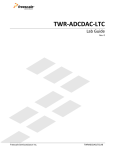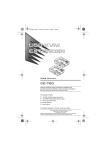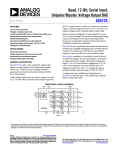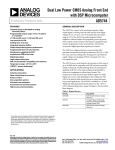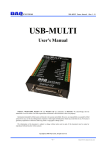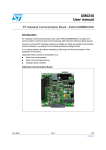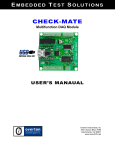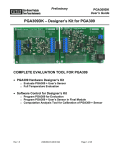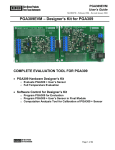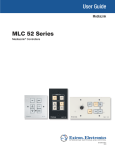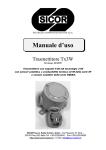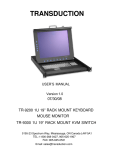Download TWR-ADCDAC-LTC Tower Module
Transcript
TWR-ADCDAC-LTC Tower Module User's Manual Rev. 0 Freescale Semiconductor Inc TWRADCDACLTCUM Table of Contents 1 TWR-ADCDAC-LTC Overview ..............................................................................................................4 1.1 Getting Started ..................................................................................................................................................................... 5 1.2 Reference Documents ....................................................................................................................................................... 5 2 Hardware Description ...........................................................................................................................6 2.1 Linear Technology Devices ............................................................................................................................................. 6 2.1.1 LTC2600 ................................................................................................................................................................................................. 6 2.1.2 LTC2704 ................................................................................................................................................................................................. 6 2.1.3 LTC2498 ................................................................................................................................................................................................. 7 2.1.4 LTC1859 ................................................................................................................................................................................................. 7 2.1.5 LTC3471 ................................................................................................................................................................................................. 7 2.1.6 LTC6655 ................................................................................................................................................................................................. 8 2.2 SPI Interface .......................................................................................................................................................................... 8 2.3 System Power .................................................................................................................................................................... 10 2.4 Input/Output Connectors............................................................................................................................................. 12 2.4.1 QuikEval Connectors ..................................................................................................................................................................... 12 2.4.2 ADC and DAC Connections .......................................................................................................................................................... 12 2.4.3 Digital Debug Connector .............................................................................................................................................................. 13 2.5 Jumper Table ..................................................................................................................................................................... 14 2.6 Tower Elevator Connections....................................................................................................................................... 15 TWRADCDACLTCUM TWR-ADCDAC-LTC Tower Module User's Manual Page 2 of 17 List of Figures Figure 1. Freescale Tower System Overview .............................................................................................. 4 The features of the TWR-ADCDAC-LTC peripheral module are listed here and pointed out in Figure 2:.. 4 Figure 2. Callouts on top side of the TWR-ADCDAC-LTC ............................................................................ 5 Figure 3. SPI Configuration Options ............................................................................................................ 9 Figure 4. Power Inputs .............................................................................................................................. 10 Figure 5. LTC3471 Switching Regulator .................................................................................................... 11 Figure 6. LTC6655-5 Voltage Reference.................................................................................................... 11 Figure 7. QuikEval Connectors .................................................................................................................. 12 Figure 8. TWR-ADCDAC-LTC Default Jumper Settings .............................................................................. 15 List of Tables Table 1. SPI Chip-Select Decoder Truth Table............................................................................................. 9 Table 2. Decoded SPI Chip-Select Device Connections............................................................................. 10 Table 3. Terminal Block Connections ........................................................................................................ 13 Table 4. Digital Debug Connector ............................................................................................................. 14 Table 5. TWR-ADCDAC-LTC Jumper Table ................................................................................................ 14 Table 6. TWR-ADCDAC-LTC Primary Connector Pinout ............................................................................ 15 Revision History Revision 1.0 TWRADCDACLTCUM Date Jan 17, 2010 Changes Initial Release TWR-ADCDAC-LTC Tower Module User's Manual Page 3 of 17 1 TWR-ADCDAC-LTC Overview The TWR-ADCDAC-LTC is a Tower Peripheral Module compatible with the Freescale Tower System (Figure 1). It features two analog-to-digital converters (ADC), two digital-to-analog converters (DAC), a voltage regulator and high-precision voltage reference from Linear Technology. SPI and I2C interface signal connections on the Primary Elevator Connector allow any Tower Controller Module with a SPI and I2C interface to configure and control all the features of the TWR-ADCDAC-LTC. Figure 1. Freescale Tower System Overview The features of the TWR-ADCDAC-LTC peripheral module are listed here and pointed out in Figure 2: Two Linear Technology digital-to-analog converters (DACs) with SPI interfaces o LTC2704-16: Quad 16-bit voltage output SoftSpan™ DAC with readback o LTC2600: Octal 16-bit rail-to-rail DACs Two Linear Technology analog-to-digital converters (ADCs) with SPI interfaces o LTC1859: 8-channel, 16-bit, 100 ksps SoftSpan ADC with shutdown o LTC2498: 24-bit 8-/16-channel delta sigma ADC with Easy Drive™ input current cancellation Linear Technology voltage regulator o LTC3471: Dual 1.3A, 1.2 MHz boost/inverter TWRADCDACLTCUM TWR-ADCDAC-LTC Tower Module User's Manual Page 4 of 17 Linear Technology voltage reference o LTC6655-5: 0.25 ppm noise, low drift precision buffered 5V reference Four 14-pin headers for connecting to any Linear Technology QuikEval™ demonstration board via I2C or SPI Figure 2. Callouts on top side of the TWR-ADCDAC-LTC 1.1 Getting Started The TWR-ADCDAC-LTC is a Tower Peripheral Module that operates under the control of a Tower Controller Module. A software Demo Suite is available and is the best way to get started and exercise the features of the TWR-ADCDAC-LTC. A separate lab guide is available to walk the user through the Demo Suite. Refer to the TWR-ADCDAC-LTC Lab Guide (TWRADCDACLTCLAB) for a list of the Tower Controller Modules that can run the Demo Suite. 1.2 Reference Documents The documents and links listed below should be referenced for more information on the TWRADCDAC-LTC and the Tower System. Freescale Tower System: www.freescale.com/tower TWR-ADCDAC-LTC Tool Support Page TWRADCDACLTCQSG: Quick Start Guide TWRADCDACLTCLAB: Lab Guide and Software TWRADCDACLTCSCH: Schematics TWR-ADCDAC-LTC-PWB: Design Package Please refer to the following links for information on the Linear Technology devices featured on the TWR-ADCDAC-LTC. LTC2600 Product Details LTC2704-16 Product Details TWRADCDACLTCUM TWR-ADCDAC-LTC Tower Module User's Manual Page 5 of 17 LTC2498 Product Details LTC1859 Product Details LTC3471 Product Details LTC6655-5 Product Details 2 Hardware Description The TWR-ADCDAC-LTC features four Linear Technology converter devices, a voltage regulator and a high precision voltage reference. Each of the ADCs and DACs on the TWR-ADCDAC-LTC provide a SPI digital interface for configuration and control. In addition, the QuikEval headers utilize either a SPI or I2C interface. This section gives an overview of each of the on-board Linear Technology devices and describes the system power and digital interface configuration options. 2.1 Linear Technology Devices This section provides a short description of each of the Linear Technology devices on the TWRADCDAC-LTC. Refer to the datasheets and product page links in the “Reference Documents” section for more product information. Refer to the TWR-ADCDAC-LTC schematics to see how these devices are connected on the TWR-ADCDAC-LTC. 2.1.1 LTC2600 The LTC2600/LTC2610/LTC2620 are octal 16-, 14- and 12-bit, 2.5V-to-5.5V rail-to-rail voltage-output DACs in 16-lead narrow SSOP and 20-lead 4mm × 5mm QFN packages. They have built-in high performance output buffers and are guaranteed monotonic. These parts establish new board-density benchmarks for 16- and 14-bit DACs and advance performance standards for output drive, crosstalk and load regulation in single-supply, voltage-output multiples. The parts use a simple SPI/MICROWIRE compatible 3-wire serial interface which can be operated at clock rates up to 50MHz. Daisychain capability and a hardware CLR function are included. The LTC2600/LTC2610/LTC2620 incorporates a power-on reset circuit. During power-up, the voltage outputs rise less than 10mV above zero-scale; and after power-up, they stay at zero-scale until a valid write and update take place. 2.1.2 LTC2704 The LTC2704-16/LTC2704-14/LTC2704-12 are serial input, 12-, 14- or 16-bit, voltage output SoftSpan™ DACs that operate from 3V to 5V logic and ±5V to ±15V analog supplies. SoftSpan offers six output spans—two unipolar and four bipolar—fully programmable through the 3-wire SPI serial interface. INL is accurate to 1LSB (2LSB for the LTC2704-16). DNL is accurate to 1LSB for all versions. Readback commands allow verification of any on-chip register in just one 24- or 32- bit instruction cycle. All other commands produce a “rolling readback” response from the LTC2704, dramatically reducing the needed number of instruction cycles. TWRADCDACLTCUM TWR-ADCDAC-LTC Tower Module User's Manual Page 6 of 17 A Sleep command allows any combination of DACs to be powered down. There is also a reset flag and an offset adjustment pin for each channel. 2.1.3 LTC2498 The LTC2498 is a 16-channel (8-differential) 24-bit No Latency ΔΣ ADC with Easy Drive technology. The patented sampling scheme eliminates dynamic input current errors and the shortcomings of on-chip buffering through automatic cancellation of differential input current. This allows large external source impedances, and rail-to-rail input signals to be directly digitized while maintaining exceptional DC accuracy. The LTC2498 includes a high accuracy temperature sensor and an integrated oscillator. This device can be configured to measure an external signal (from combinations of 16 analog input channels operating in single ended or differential modes) or its internal temperature sensor. The integrated temperature sensor offers 1/30th °C resolution and 2°C absolute accuracy. The LTC2498 allows a wide common mode input range (0V to VCC), independent of the reference voltage. Any combination of single-ended or differential inputs can be selected and the first conversion after a new channel is selected is valid. Access to the multiplexer output enables optional external amplifiers to be shared between all analog inputs and auto calibration continuously removes their associated offset and drift. 2.1.4 LTC1859 The LTC1857/LTC1858/LTC1859 are 8-channel, low power, 12-/14-/16-bit, 100ksps, analog-to-digital converters (ADCs). These SoftSpan™ ADCs can be software programmed for 0V to 5V, 0V to 10V, ±5V or ±10V input spans and operate from a single 5V supply. The 8-channel multiplexer can be programmed for single-ended inputs or pairs of differential inputs or combinations of both. In addition, all channels are fault protected to ±25V. A fault condition on any channel will not affect the conversion result of the selected channel. An onboard high performance sample-and-hold and precision reference minimize external components. The low 40mW power dissipation is made even more attractive with two user selectable power shutdown modes. DC specifications include ±3LSB INL for the LTC1859, ±1.5LSB INL for the LTC1858 and ±1LSB for the LTC1857. The internal clock is trimmed for 5µs maximum conversion time and the sampling rate is guaranteed at 100ksps. A separate convert start input and data ready signal (BUSY) ease connections to FIFOs, DSPs and microprocessors. 2.1.5 LTC3471 The LT3471 dual switching regulator combines two 42V, 1.3A switches with error amplifiers that can sense to ground providing boost and inverting capability. The low VCESAT bipolar switches enable the device to deliver high current outputs in a small footprint. The LT3471 switches at 1.2MHz, allowing the use of tiny, low cost and low profile inductors and capacitors. High inrush current at start-up is eliminated using the programmable soft-start function, where an external RC sets the current ramp rate. A constant frequency current mode PWM architecture results in low, predictable output noise that is easy to filter. TWRADCDACLTCUM TWR-ADCDAC-LTC Tower Module User's Manual Page 7 of 17 The LT3471 switches are rated at 42V, making the device ideal for boost converters up to ±40V as well as SEPIC and flyback designs. Each channel can generate 5V at up to 630mA from a 3.3V supply, or 5V at 510mA from four alkaline cells in a SEPIC design. The device can be configured as two boosts, a boost and inverter or two inverters. The LT3471 is available in a low profile (0.75mm) 10-lead 3mm × 3mm DFN package. 2.1.6 LTC6655 The LTC6655 is a complete family of precision bandgap voltage references, offering exceptional noise and drift performance. This low noise and drift is ideally suited for the high resolution measurements required by instrumentation and test equipment. In addition, the LTC6655 is fully specified over the temperature range of –40°C to 125°C, ensuring its suitability for demanding automotive and industrial applications. Advanced curvature compensation allows this bandgap reference to achieve a drift of less than 2ppm/°C with a predictable temperature characteristic and an output voltage accurate to ±0.025%, reducing or eliminating the need for calibration. The LTC6655 can be powered from as little as 500mV above the output voltage to as much as 13.2V. Superior load regulation with source and sink capability, coupled with exceptional line rejection, ensures consistent performance over a wide range of operating conditions. A shutdown mode is provided for low power applications. Available in a small MSOP package, the LTC6655 family of references is an excellent choice for demanding precision applications. 2.2 SPI Interface There are eight possible SPI devices on the TWR-ADCDAC-LTC: four ADC and DAC devices and four QuikEval connectors. The Primary Elevator Connector of the Tower System defines two SPI interface connections, but each only offers up to two chip-selects. Therefore, a 74HC138 3-to-8 line decoder along with three GPIO signals is used to generate the eight chip-select signals needed to accommodate all the possible SPI devices on the board. Figure 3 shows the schematic connections for the SPI configuration selections. Refer to Section 2.4.3 “Jumper Table” for more details on the jumper selection options. The three signals decoded by the 74HC138 to generate the SPI chip-select signals can be driven by GPIO signals from the Primary Elevator Connector (GPIO7-9) or they can be set by jumper options J14J16. Table 1 shows how the logic level on the three decoder inputs map to the SPI chip-select signals. Table 2 shows the devices to which the decoded chip-selects are connected. TWRADCDACLTCUM TWR-ADCDAC-LTC Tower Module User's Manual Page 8 of 17 Figure 3. SPI Configuration Options Table 1. SPI Chip-Select Decoder Truth Table GPIO9 GPIO8 GPIO7 J14 J15 J16 L L L L H H H H TWRADCDACLTCUM L L H H L L H H L H L H L H L H 0 L H H H H H H H Decoded SPI Chip-Select 1 2 3 4 5 6 H H H H H H L H H H H H H L H H H H H H L H H H H H H L H H H H H H L H H H H H H L H H H H H H 7 H H H H H H H L TWR-ADCDAC-LTC Tower Module User's Manual Page 9 of 17 Table 2. Decoded SPI Chip-Select Device Connections Decoded CS Signal SPI_CS_DEC0 SPI_CS_DEC1 SPI_CS_DEC2 SPI_CS_DEC3 SPI_CS_DEC4 SPI_CS_DEC5 SPI_CS_DEC6 SPI_CS_DEC7 Device QuikEval J22 QuikEval J21 QuikEval J20 QuikEval J19 LTC2704 LTC2600 LTC2498 LTC1859 2.3 System Power The Freescale Tower System supplies 3.3V and 5V supplies on the Elevator Connectors. However, the TWR-ADCDAC-LTC can—and by default, does—generate its own voltage supply and voltage reference from the 5V input on a standard mini-B USB connector (J33). As shown in Figure 4, jumper J30 can optionally be used to provide 5V from the Tower Elevator Connectors. Figure 4. Power Inputs The LTC3471 dual switching regulator (Figure 5) boosts and inverts the 5V input to generate clean +15V and -15V supply rails used by the LTC2704 ADC and the LTC6655-5 voltage regulator. TWRADCDACLTCUM TWR-ADCDAC-LTC Tower Module User's Manual Page 10 of 17 Figure 5. LTC3471 Switching Regulator The LTC6655-5 precise bandgap voltage reference (Figure 6) uses the +15V as the input voltage generate a low-noise, low-drift 5.0V reference voltage used by the on-board ADCs and DACs. Figure 6. LTC6655-5 Voltage Reference TWRADCDACLTCUM TWR-ADCDAC-LTC Tower Module User's Manual Page 11 of 17 2.4 Input/Output Connectors All the input and output connections on the TWR-ADCDAC-LTC are described in the following sections. 2.4.1 QuikEval Connectors The QuikEval Connectors utilize either an I2C or SPI interface. Jumpers (J1-J8) are provided to select between I2C and SPI. These connectors can be used to connect to any Linear Technology evaluation board that is a member of the QuikEval family. Figure 7. QuikEval Connectors 2.4.2 ADC and DAC Connections The inputs and outputs of the four converter devices on the TWR-ADCDAC-LTC are brought to terminals on screw-in terminal blocks. The following table provides the information for how the signals are connected to the terminal blocks. TWRADCDACLTCUM TWR-ADCDAC-LTC Tower Module User's Manual Page 12 of 17 Table 3. Terminal Block Connections LTC Device LTC2600 DAC LTC2704 DAC LTC2498 ADC LTC1859 ADC Signal Connection Label ― VOUTA VOUTB VOUTC VOUTD VOUTE VOUTF VOUTG VOUTH ― ― VOUTA ― VOUTB ― VOUTC ― VOUTD ― COM CH0 CH1 CH2 ― ― CH3 CH4 CH5 CH6 CH7 ― COM CH0 CH1 CH2 CH3 ― CH4 CH5 CH6 CH7 ― J18 pin 1 J18 pin 2 J18 pin 3 J18 pin 4 J18 pin 5 J18 pin 6 J18 pin 7 J18 pin 8 J18 pin 9 J18 pin 10 J17 pin 1 J17 pin 2 J17 pin 3 J17 pin 4 J17 pin 5 J17 pin 6 J17 pin 7 J17 pin 8 J26 pin 1 J26 pin 2 J26 pin 3 J26 pin 4 J26 pin 5 J26 pin 6 J26 pin 7 J26 pin 8 J26 pin 9 J26 pin 10 J26 pin 11 J26 pin 12 J27 pin 1 J27 pin 2 J27 pin 3 J27 pin 4 J27 pin 5 J27 pin 6 J27 pin 7 J27 pin 8 J27 pin 9 J27 pin 10 J27 pin 11 J27 pin 12 GND A B C D E F G H GND GND A GND B GND C GND D GND COM 0 1 2 GND GND 3 4 5 6 7 GND COM 0 1 2 3 GND 4 5 6 7 GND 2.4.3 Digital Debug Connector A 1x10, 0.1” pitch header with many of the digital communication signals is provided for easy debug access. Refer to Table 4 to the signal connection details. TWRADCDACLTCUM TWR-ADCDAC-LTC Tower Module User's Manual Page 13 of 17 Table 4. Digital Debug Connector J38 Pin Number 1 2 3 4 5 6 7 8 9 10 Signal Connection SPI_CS_DEC4 SPI_CS_DEC5 SPI_CS_DEC6 SPI_CS_DEC7 SPI_CLK SPI_MOSI SPI_MISO SCL0 SDA0 GND 2.5 Jumper Table There are several jumpers on the TWR-ADCDAC-LTC that provide configuration selection and signal isolation. Refer to the following table for details. The default installed jumper settings are shown in bold. The default jumper shunt locations are also shown in Figure 8. Table 5. TWR-ADCDAC-LTC Jumper Table Jumper J1 - J8 Option QuikEval I2C/SPI Selection J9 SPI Port Selection -- SPI_CLK J10 SPI Port Selection -- SPI0_CSx J11 SPI Port Selection -- SPI1_CSx J12 SPI Port Selection -- SPI_MOSI J13 SPI Port Selection -- SPI_MISO J25 SPI Port Selection -- SPI_CS J14 SPI Chip-Select Encoding Bit 0 Setting J15 SPI Chip-Select Encoding Bit 1 Setting J16 SPI Chip-Select Encoding Bit 2 Setting J28, J29 J31, J32 J30 LTC2704 VOSx GND Connection Tower Power Connection TWRADCDACLTCUM Setting 1-2 2-3 1-2 2-3 1-2 2-3 1-2 2-3 1-2 2-3 1-2 2-3 1-2 2-3 1-2 2-3 OFF 1-2 2-3 OFF 1-2 2-3 OFF ON OFF ON OFF Description Connect I2C signals to QuikEval header Connect SPI signals to QuikEval header Use SPI_CLK signal from SPI0 Use SPI_CLK signal from SPI1 Select SPI0_CS0 Select SPI0_CS1 Select SPI1_CS0 Select SPI1_CS1 Use SPI_MOSI signal from SPI0 Use SPI_MOSI signal from SPI1 Use SPI_MISO signal from SPI0 Use SPI_MISO signal from SPI1 Use SPI0_CSx (see J10) Use SPI1_CSx (see J11) Connected to 3.3V Connected to GND Driven by GPIO9 Connected to 3.3V Connected to GND Driven by GPIO8 Connected to 3.3V Connected to GND Driven by GPIO7 Connect VOSA, VOSB, VOSC, VOSD to GND Disconnect VOSx from GND Connect on-board 5V rail to Tower System Isolate on-board 5V rail from Tower System TWR-ADCDAC-LTC Tower Module User's Manual Page 14 of 17 Jumper Option J34 LT3471 Shutdown J37 LTC1859 Reference Voltage Selection Setting 1-2 2-3 ON OFF Description LT3471 voltage regulator enabled LT3471 voltage regulator disabled Use output of LTC6655-5 as reference Use GND as reference Figure 8. TWR-ADCDAC-LTC Default Jumper Settings 2.6 Tower Elevator Connections The TWR-ADCDAC-LTC features two expansion card-edge connectors that interface to the Primary and Secondary Elevator boards in a Tower system. The Primary Connector (comprised of sides A and B) is utilized by the TWR-ADCDAC-LTC while the Secondary Connector (comprised of sides C and D) only makes connections to the GND pins. Table 6 provides the pinout for the Primary Connector. An “X” in the “Used “column indicates that a connection is made to that pin on the connector. An “X” in the “Jmp” column indicates that a jumper or other option is provided to remove or configure the connection—thus the connection can be removed if required. Table 6. TWR-ADCDAC-LTC Primary Connector Pinout TWR-ADCDAC-LTC Primary Connector Side B Pin # Name B1 5V TWRADCDACLTCUM Usage 5.0V Power Used X Jmp Side A Pin # Name A1 5V TWR-ADCDAC-LTC Tower Module User's Manual Usage 5.0V Power Used Jmp X Page 15 of 17 TWR-ADCDAC-LTC Primary Connector Side B Pin # Name B2 GND Ground B3 3.3V 3.3V Power B4 ELE_PS_SENSE B5 B6 Side A Pin # Name X A2 GND Ground X X A3 3.3V 3.3V Power X Power Sense X A4 3.3V 3.3V Power X GND Ground X A5 GND Ground X GND SDHC_CLK / SPI1_CLK Ground SPI1_CLK X X A6 B7 X A7 GND SCL0 Ground SCL0 X X X B8 SDHC_D3 / SPI1_CS1_b X X A8 SDA0 SDA0 X X B9 SDHC_D3 / SPI1_CS0_b SPI1_CS1 SPI1_CS0 X X A9 GPIO9 / CTS1 GPIO9 X X B10 SDHC_CMD / SPI1_MOSI SPI1_MOSI X X A10 GPIO8 / SDHC_D2 GPIO8 X X B11 SDHC_D0 / SPI1_MISO SPI1_MISO X X A11 GPIO7 / SD_WP_DET GPIO7 X X Ground X Ground X 3.3V Power X Usage Used Jmp B12 ETH_COL A12 ETH_CRS B13 ETH_RXER A13 ETH_MDC B14 ETH_TXCLK A14 ETH_MDIO B15 ETH_TXEN A15 ETH_RXCLK B16 ETH_TXER A16 ETH_RXDV B17 ETH_TXD3 A17 ETH_RXD3 B18 ETH_TXD2 A18 ETH_RXD2 B19 ETH_TXD1 A19 ETH_RXD1 B20 ETH_TXD0 A20 ETH_RXD0 B21 GPIO1 / RTS1 A21 SSI_MCLK B22 GPIO2 / SDHC_D1 A22 SSI_BCLK B23 GPIO3 A23 SSI_FS A24 SSI_RXD A25 SSI_TXD A26 B24 CLKIN0 B25 CLKOUT1 B26 B27 GND AN7 A27 GND AN3 B28 AN6 A28 AN2 B29 AN5 A29 AN1 B30 AN4 A30 AN0 B31 GND DAC1 A31 B32 A32 GND DAC0 B33 TMR3 A33 TMR1 B34 TMR2 A34 TMR0 B35 GPIO4 A35 GPIO6 B36 A36 B37 3.3V PWM7 A37 3.3V PWM3 B38 PWM6 A38 PWM2 B39 PWM5 A39 PWM1 B40 PWM4 A40 PWM0 B41 CANRX0 A41 RXD0 B42 CANTX0 A42 TXD0 B43 1WIRE A43 RXD1 B44 SPI0_MISO SPI0_MISO X X A44 TXD1 B45 SPI0_MOSI SPI0_MOSI X X A45 VSS B46 SPI0_CS0_b SPI0_CS0 X X A46 VDDA B47 SPI0_CS1_b SPI0_CS1 X X A47 VREFA1 TWRADCDACLTCUM Ground Ground 3.3V Power X X X TWR-ADCDAC-LTC Tower Module User's Manual Usage Used Jmp Page 16 of 17 TWR-ADCDAC-LTC Primary Connector Pin # B48 B49 Side B Name SPI0_CLK Usage SPI0_CLK X Jmp X Side A Pin # Name A48 VREFA2 B50 GND SCL1 B51 SDA1 A51 GPIO15 B52 GPIO5 / SD_CARD_DET A52 GPIO16 B53 USB0_DP_PDOWN A53 B54 A54 GPIO17 USB0_DM B55 USB0_DM_PDOWN IRQ_H A55 USB0_DP B56 IRQ_G A56 USB0_ID B57 IRQ_F A57 USB0_VBUS B58 IRQ_E A58 TMR7 B59 IRQ_D A59 TMR6 B60 IRQ_C A60 TMR5 B61 IRQ_B A61 TMR4 B62 IRQ_A A62 RSTIN_b B63 EBI_ALE / EBI_CS1_b A63 RSTOUT_b B64 EBI_CS0_b A64 CLKOUT0 B65 GND A65 GND B66 EBI_AD15 A66 EBI_AD14 B67 EBI_AD16 A67 EBI_AD13 B68 EBI_AD17 A68 EBI_AD12 B69 A69 EBI_AD11 B70 EBI_AD18 EBI_AD19 A70 EBI_AD10 B71 EBI_R/W_b A71 EBI_AD9 B72 EBI_OE_b A72 EBI_AD8 B73 EBI_D7 A73 EBI_AD7 B74 EBI_D6 A74 EBI_AD6 B75 EBI_D5 A75 EBI_AD5 B76 EBI_D4 A76 EBI_AD4 B77 EBI_D3 A77 EBI_AD3 B78 EBI_D2 A78 EBI_AD2 B79 EBI_D1 A79 EBI_AD1 B80 EBI_D0 A80 EBI_AD0 B81 GND Ground X A81 B82 3.3V 3.3V Power X A82 TWRADCDACLTCUM Ground Used X Ground X A49 GND A50 GPIO14 Usage Used Ground X GND Ground X 3.3V 3.3V Power X TWR-ADCDAC-LTC Tower Module User's Manual Jmp Page 17 of 17

















